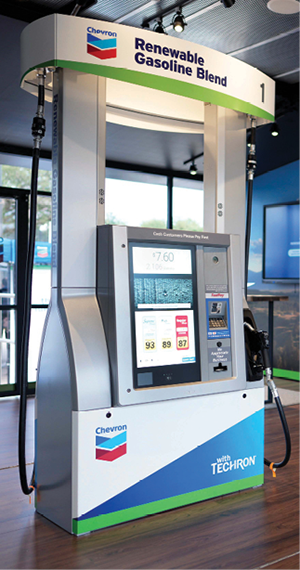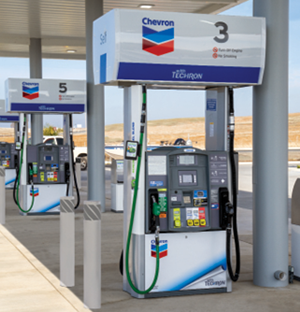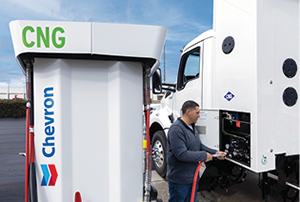Over the last 143 years, Chevron has weathered numerous energy transitions. Today, Chevron’s differentiated energy transition strategy is to lower the carbon intensity of its operations and expand lower carbon businesses, including a rapidly growing lower carbon fuels business.
Regardless of where retailers, marketers or station owners are on their lower carbon journey, Chevron has a product to fulfill the needs of its customers. Chevron offers solutions that are fit-for-purpose, with customer needs varying by regulation, fleet size, geography and payload/cargo. Operators benefit from close retail partnerships and the education that comes with Chevron’s product evolution and initiatives.

A recent notable achievement is the demonstration of Chevron’s renewable gasoline blend, an innovative new fuel which aims to help address transportation sector carbon emissions. It has a life cycle carbon intensity that at scale production would be more than 40% lower than traditional gasoline. Chevron’s renewable gasoline blend, a drop-in fuel, is compatible with current infrastructure and gasoline-fueled engines on the road today. If produced and marketed at scale, this lower-carbon-intensity gasoline could unlock the potential for motorists to be a part of a lower carbon future without switching vehicles.
These renewable gasoline blends are designed to be seamlessly integrated into the light-duty sector, with no changes to existing engines or infrastructure. This makes them an appealing option for reducing life cycle carbon emissions in the near-term. The fuel performs interchangeably with traditional gasoline but emits less carbon dioxide on a life cycle basis.
Chevron Expands Quality Renewable Biodiesel Offering
In June 2022, Chevron acquired Renewable Energy Group (REG) to boost its renewable fuels expertise. Founded in the late 1990s, Renewable Energy Group has grown to have a portfolio of 11 biodiesel and renewable diesel production facilities in the United States and Europe and is one of the largest biofuels producers in the United States.
Chevron Renewable Energy Group spent over six years developing a next-generation, high-quality biodiesel. This biodiesel is produced using advanced refining processes and testing procedures for blending with renewable diesel and is used to create Chevron renewable diesel blends. These blends are currently offered throughout California and are expanding into the Pacific Northwest. Chevron’s renewable diesel blend is compatible with current station infrastructure and diesel-fueled vehicles on the road today.

The Chevron Portfolio for Driving Lower Carbon Intensity
Chevron is deploying a portfolio of reliable and competitive options of lower carbon intensity products. By reducing the carbon intensity of its own operations, Chevron is providing lower carbon intensity traditional fuels. Additionally, Chevron offers easy-to-adopt lower carbon intensity options such as renewable diesel and biodiesel that can be used in existing diesel engines with no modifications and are immediately adoptable. Chevron continues to progress actions in offering an expanded portfolio of options for today and tomorrow.
Primary focus areas for development and innovation include:
• Renewable diesel (RD)
• Biodiesel (BD)
• Renewable diesel blend (RDB)
• Compressed natural gas (CNG)
• Renewable natural gas (RNG)
• Hydrogen (H2)
• Sustainable aviation fuel (SAF)
• Renewable gasoline blend (RGB)
Chevron’s renewable diesel blend is a diesel fuel made with at least 80% renewable diesel and up to 20% biodiesel, typically with no more than 1% conventional petroleum diesel. In limited applications, the blend ratios of Chevron’s renewable diesel blend may be altered to include more petroleum diesel to manage cold flow properties. Primarily made from biofeedstocks, Chevron’s renewable diesel blend provides a lower life cycle carbon intensity than conventional petroleum diesel.
The terms “renewable diesel” and “biodiesel” are often used interchangeably, although the fuels are produced differently. Both renewable diesel and biodiesel are derived from the same types of feedstocks, which can include soybean oil, used cooking oil, tallow and other plant- and animal-based oils. The primary difference is in the way each is processed into a fuel, which affects their composition.
Chevron renewable diesel blend has physical properties that benefit the combustion process in diesel engines, resulting in lower engine-out emissions of hydrocarbons, carbon monoxide and particulates than conventional petroleum diesel. It also has a greater cetane number than conventional petroleum diesel, which can improve cold start performance in certain engines and high lubricity. This can minimize friction between, and damage to, surfaces in relative motion under load.
Chevron Expands CNG Station Network and RNG Supply
While trucking mostly relies on diesel to fuel its engines, a move toward natural gas can be an important step forward in further lowering fleet carbon emissions. Chevron is proud to help increase compressed natural gas (CNG) fuel availability, which can enable faster adoption.
Chevron is developing and constructing hydrogen fueling sites in California.
CNG is natural gas (methane) that is stored and transported under high pressure in its gaseous state. When compared to conventional diesel, CNG has many advantages. CNG can be priced lower (as with all products, prices can fluctuate), have a lower carbon intensity based on reduced emissions across its production life cycle, and lower engine emissions of nitrous oxide (NOx) and particulate matter. Additionally, the range of natural gas-powered heavy-duty trucks typically exceeds electric-powered trucks relying on still-emerging electric vehicle technology. Switching to natural gas engines can help companies and fleets meet their lower carbon and compliance goals.

Renewable natural gas (RNG) comes from naturally occurring biomethane from multiple sources including livestock waste, landfills, wastewater sludge, food waste and other organic waste operations. The raw biomethane is captured and upgraded to remove contaminants and can be injected into existing natural gas pipeline networks and used as a substitute virtually indistinguishable from natural gas.
Chevron continues to make strides in CNG and RNG through several ongoing projects, all part of the continued pursuit of progressing lower carbon intensity value chains. Here are some outstanding examples:
- Chevron completed its acquisition of Beyond6 in December 2022, expanding its national network of compressed natural gas (CNG) stations; there are 58 stations in the network today that are online and ready to receive fleet customers. Additionally, there are multiple projects planned or in construction to further expand the fueling network.
- Chevron partners with industry experts to build and operate a nationwide system of anaerobic digestion dairy farm projects, in which dairy manure serves as the feedstock. These digesters capture and upgrade the methane from manure and inject it into a nearby gas pipeline network.
- As a point of progress for advancing a lower carbon economy, Walmart’s first CNG-powered truck marked a milestone in 2023 when it took an inaugural drive from Arkansas to California. Throughout the road trip, the15-liter CNG engine that was supplied by engine manufacturer Cummins was fueled by Chevron with compressed natural gas (CNG) linked to renewable natural gas (RNG).
Hydrogen Value Chain in Development
Hydrogen is the most abundant element in the universe, and according to the U.S. Department of Energy, engines fueled with it can be twice as efficient as a combustion engine. Today there are about 16,000 fuel cell electric vehicles (FCEVs) on the road (according to the organization Hydrogen Fuel Cell Partnership), and they are growing in popularity. There are zero tailpipe carbon emissions from FCEVs and these vehicles can represent a significant reduction in carbon intensity as compared to traditional fuels.
In another example of innovation, Chevron is developing its hydrogen value chain. The value chain includes production, transportation and fueling infrastructure. Over time, the value chain will grow to deliver hydrogen at scale to hard-to-abate (also known as hard-to-electrify) industries, such as medium- and heavy-duty transportation.
Chevron is developing and constructing hydrogen fueling sites in California; the first is breaking ground in late 2023. These sites will be located at Chevron-branded retail stations across the state and will initially fuel light-duty vehicles while retaining the flexibility to service heavy-duty vehicles over the long term. To learn more about how Chevron is innovating, visit www.Chevron.com/franchise.
Lowering Carbon Intensity
Per the Transportation Energy Institute, reducing the greenhouse gas emissions associated with transportation fuels is important in order to enable companies to meet regulations and achieve their own sustainability goals. In its Decarbonizing Combustion Vehicles report, published in July 2023, the Transportation Energy Institute shows how some alternative fuels generally compare to traditional products. The chart below shows fuel carbon intensity assumptions. Offering alternative fuels that are adoptable can help companies comply with regulations and allows them to meet their lower carbon aspirations.
